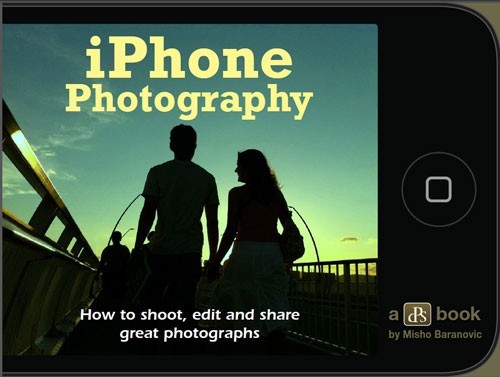Photographer and iPhoneographer Misho Baranovic has been creating and sharing iPhone photography since the art’s early days. He’s a charter member of the Mobile Photography Group with other notable iPhoneographers.
Misho has just published a digital book, “iPhone Photography: How to Shoot, Edit and Share Great Photos”, in which he shares a lot of information on how to shoot great photos, edit them, and share them. It’s a great, single-volume course on the complete iPhoneography workflow. More important, he graciously shares priceless information and experience that iPhoneographers of all skill levels will find very valuable.
UPDATED: 08.11.13
Taking good photographs involves luck, skill, a good eye, and a knowledge of your tools and various rules of photography and aesthetics. Photographers work for years learning and honing these skills. This book helps iPhoneographers, especially novices and those with limited experience, fast-track that knowledge.
Misho is a professional photographer who has also embraced iPhoneography. In his book, he doesn’t just give you step-by-step instructions on how to take iPhone pictures and app them (although that’s in there), he teaches the reader on how to take better pictures using the iPhone as a camera and processing tool.
The book is divided into three sections: Shoot, Edit, and Share. Each section is further broken down and guides you step-by-step through each part of the process using real-world examples. iPhoneographers just starting to expand beyond the one-click simplicity of Instagram will appreciate Misho’s instructive attention to detail. The book is well designed and more advanced iPhoneographers can easily skip past the basics, although I highly recommend that you read it cover to cover regardless of your skill level. There are a lot of valuable photographic and iPhoneographic tidbits spread throughout the book.
Surprisingly, my favorite section of the book was Section One: Shoot. Misho discusses many aspects of capturing images with the iPhone’s camera. It’s packed with tutorials and tips on how to grip the iPhone for better shooting, Apple Camera basics, a very interesting guide through iOS 5’s Photos app and a lot more.
Shoot takes the reader beyond the basic Camera. Misho shares the pros and cons of several of the most widely used camera replacement apps. It’s a great infographic and a good reference. There is an excellent tutorial on ProCamera.
The section has tutorials on lighting, exposure and composition from the perspective of the iPhone camera’s limitations. There’s even a chapter devoted to gear you’ll need when traveling.
Like other sections of the book, Misho interviews other high-profile pioneers of iPhoneography, including Aik-Beng Chia, Jordi V. Pou, Robert-Paul Jansen and others. Not only do these interviews give the text a different voice, but they contribute additional experience and perspectives. These interviews make “iPhone Photography:….” a unique and more valuable resource in that regard.
Section Two is probably the weakest of the three sections. It’s still a good tutorial and overview of several photo apps many long-time iPhoneographers have gravitated towards. It includes tutorials on photo apps Cross Process, Camera+, Phoster and brief overviews of a few others. There’s a good tutorial on getting the most out of the popular Hipstamatic and a fantastic tutorial on the powerful photo app Snapseed and its tools and capabilities. This section is like a “missing manual” for Snapseed.
Section Three not only takes the reader through basic sharing, but teaches philosophies and recommendations to help better improve your reach through social media and other sharing channels. Misho goes over in detail most of the popular photo sharing apps — sharing pathways, key apps, group formation, exhibition and printing. This section touches upon showing your works in print in galleries and even includes an abridged version of Life In LoFi’s Photo Print Size chart. There’s a lot in this section. It’s packed with essential sharing and displaying tips for beginners and even more experienced iPhonegraphers will learn a few things from this section.
The book is intelligently written yet easy to read. It never talks down to the reader. My only disappointment in the book is that Section Two: Edit is pretty light on apps. Some of the app choices made me scratch my head a little. There are hundreds of great photo apps available and I feel the book would have been even better had it covered a few more of the major ones, such as Filterstorm, PhotoForge2, 645PRO, or some of the specialized photo effects apps. However, these omissions are more than made up for the photographic perspectives, real-world shooting experience and photographic philosophies that the book shares. That information is invaluable and often much harder to come by.
Overall, I really like “iPhone Photography: How to Shoot, Edit and Share Great Photos”. It’s a quick, thorough iPhoneography tutorial by Misho Baranovic with sidebars from several of the most prominent iPhoneographers shooting today. For $20 and the investment in time to read it, beginners can quickly learn many techniques it might have taken them much longer to acquire through trial and error. I strongly recommend this book to beginners in particular for learning good shooting techniques and photographic theory. Right away, the tips in the first section of this book will help you take better photographs. The tips on sharing will help all iPhoneographers broaden their reach and audience. For more advanced iPhonegraphers, the Snapseed tutorial and the perspectives and shares of Misho and other iPhoneographers make this a worthwhile consideration.
“iPhone Photography: How to Shoot, Edit and Share Great Photos” by Misho Baranovic is $19.99 and is available as a digital download only in PDF and EPUB formats.
Click here to order your copy or to view more details
=M=
..




